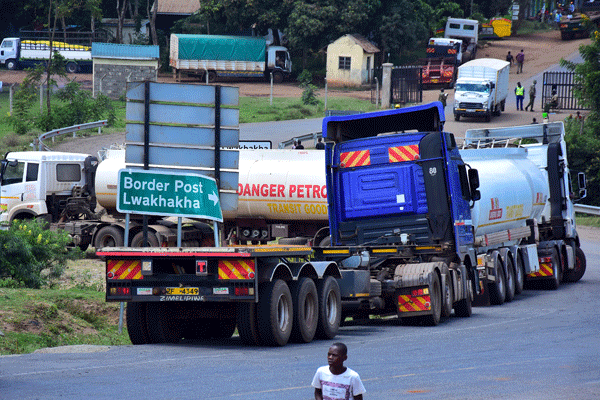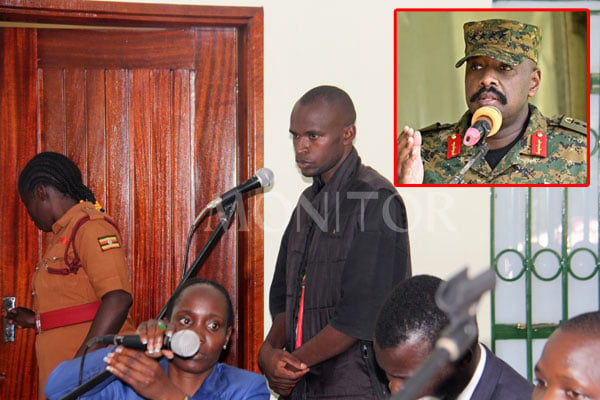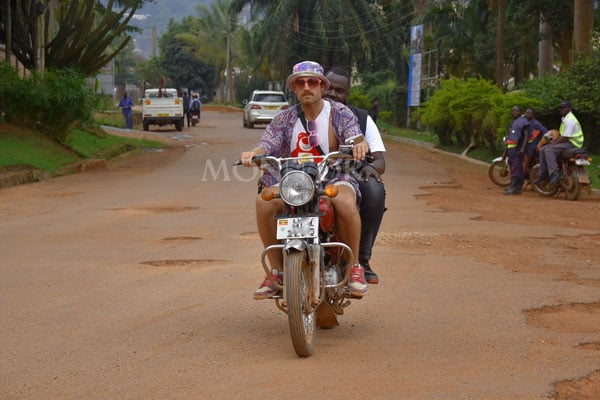Sugarcane growing: Is it a raw deal for farmers?

Trucks on Mayuge highway transport sugar canes to Mayuge Sugar factory. Busoga Sub-region whose primary economic activity is sugarcane growing has persistently been among the poorest of the communities in the country. PHOTO/DENIS EDEMA
What you need to know:
Sugar prices drop. There must be a way to make the sugar price more sustainable, with the farmers taking home a fair chunk of the total amount.
Despite government earmarking sugarcane as one of the 14 strategic cash crops, it has not really transformed livelihoods andhousehold incomes of the farmers who are commercially engaged in it.
This is a consensus that most key stakeholders apart from some manufacturers of this commodity, largely concur with.
According to an in-depth analysis of the sugar sub-sector, there is a massive variance between the livelihood and the income levels of the people engaged in sugarcane growing, raising the question whether this economic activity is worth farmers’ time or it is about time they ditched it for another viable venture.
This is because for years if not decades, poverty has been a permanent fixture in the sugarcane growing areas with Busoga sub-region being a perfect example.
The irony is that there has been increased cane production and milling capacity over the last two and half decades which essentially should result into potential employment opportunities with better incomes, reduced poverty and guaranteed food security.
But this hasn’t entirely been the case according to available studies, including one done by Uganda Bureau of Statistics (UBOS), and now Economic Policy Research Centre (EPRC). All these reports indicate that Busoga Sub-region whose primary economic activity is sugarcane growing has persistently been among the poorest of the communities in the country, raising fears of what will become of communities elsewhere in the country that are trying to get into sugarcane growing.

A man packages sugar in a factory. PHOTO/Tausi nakato and DENIS EDEMA
About 25 per cent of people in Busoga are below the poverty line. This, according to government is an indication of how badly spread the distribution of benefits emanating from sugarcane growing value chain is. The farmers who play a central role in supplying cane to milling companies remain largely excluded in the governance and decision making structure.
Governance challenges
The absence of a Sugar Board, which should be up and running by now remains a major concern. According to the EPRC report, titled: “Rethinking Sugarcane Governance Structures to Better Address Rural Poverty and Food Insecurity”, limited coordination at production level has negatively affected capacity of grower associations bargaining power. This is in addition to weakened coordination between growers and millers, resulting into emergence of new small mills which weakens out-grower schemes.
In his presentation at the virtual 9th National Forum on Agriculture and Food Security held in Kampala recently, the EPRC senior research fellow, Dr Swaibu Mbowa, noted while keeping a lid on that, he believes that it is critical to manage EAC sugar trade relations, considering their impact on sugarcane prices.
Regulation
Government has tried to regulate the sugar industry through establishing the sugar board to expand the cash crop’s value addition beyond sugar. This however is still in abeyance.
While that effort could be useful, once it comes to fruition, Dr Mbowa’s research reveals that sugar cane production has been exponentially rising without notable effects on livelihoods and income levels. In the last six decades, Uganda’s sugarcane production has increased from one million metric tonne to five million metric tonnes.
According to the EPRC analysis, the increase in sugarcane production is sadly not as a result of enhancement in productivity but due to expanded land to produce the cash crop. It further emerged that most of the expanded land being used for growing more sugarcane is part of the forests that have been converted into sugarcane farmland. There is evidence showing that land which was supposed to be used for growing food crops was converted into growing thecash crop. Then there is a reduction of farmers engaged in production but instead rent out the land.
Meanwhile, the increase in milling capacity has also gone up from just three in the 1970s to now more than 33 milling plants licensed by the government, explaining the expansion in processing capacity over time.
Majority of the milling plants are in the Eastern region, particularly in Busoga region with 35 per cent, followed by the Central region with 27 per cent, then Western region at 26 and Northern region at 20 per cent.
As all that plays out, researcher Mbowa noted that: “We are seeing decline in sugar prices.” This could perhaps explain the poverty situation in Busoga sub-region and other sugarcane growing areas around the country.
Sugarcane prices in free fall
It became obvious in the report that the prices have been in free fall since 2017 when a farmer would earn Shs180, 000 per metric tonne. But today, the same farmer receives just about Shs60, 000 from the same volume. Disturbingly perhaps, speculators have made inroads into the industry. After gaining access to the permits, they instead buy the entire sugarcane field instead of the tonnage produced.
“Sugarcane is a perennial crop that takes 18 months to mature. So you can imagine renting your land for that long amidst declining sugar prices, that definitely has implications on incomes, food security and is a breeding ground for poverty,” Dr Mbowa said in his presentation last week in Kampala.
No wonder, Busoga sub-region, home to 1.2 million poor persons, with almost half a million continue to wallow in poverty despite being a resident to the leading sugar processing industry.
Coupled with the weakened coordination between the growers and millers, let alone the limited government support to sugarcane sub-sector as evidenced by the delay to establish the sugarcane board, means the industry is in for a long haul.
EAC trade relations
Dr Mbowa was also of the view that managing the EAC sugar trade relations is not only complex but laborious. Any ban on export of Uganda’s sugar in the EAC market means farmers will be stuck with the canes while millers accumulate stocks before eventually stopping the purchase of sugarcane.
Government remains hopeful about sugarcane production, given its perks in terms of revenue collection it generates from the sugar manufactures.
According to the State Minister for Trade, Mr David Bahati, once the sugarcane issues are resolved, its contribution to the household incomes and by extension to the economy, will only get better.
Speaking at the launch of the EPRC report, he said the ongoing discussion around sugarcane is timely as it is happening at a time when government has put in place key governance reforms for sugar sector.
He said: “Government has identified sugarcane as one of the strategic crops where co-investment with the private sector will be directed over the current planning period.”
He continued: “There are several planned and ongoing investments in the sugarcane sub-sector by government and through Uganda Development Corporation, we shall be investing over a trillion shillings in a couple of years that will be provided to support this sector.”
It should be noted that the government has partnered and supported the construction of Atiak sugar factory in northern Uganda and a similar arrangement through UDC will be implemented in Busoga sub-region.
“Government is going to work with people in Busoga to set up a factory in Busoga sub region using the Atiak model. We are going to invest some money in the industry where we will have at least 40 per cent stakes and then the rest remains in the private sector,” he revealed, before concluding, “We think that the partnership either through cooperatives or private sector is a good model so that the government is not wholly in this but also the private sector is participating.”
In addition, government will set up sugarcane value addition incubation centres in each district in the Busoga sub region. Government will support establishment of the National Sugar Research Centre to improve sugarcane for higher yields.
Further, the government will support strategic private industries to develop sugar refineries that will address the local demand for refined sugar. There are already plans to introduce a 10 per cent breeding policy to support domestic production and consumption of bio-thermal fuel.
Regarding the key reforms, he said, government has responded to the institutional needs of the sugarcane sub-sector by signing a Sugar Act 2020 into law to regulate sugar production and trading.
Among others, the Act provides establishment of the sugar board to regulate activities of value chain actors including sugar cane growers and millers, before stressing that government is in the process of setting up the sugar board.
Intricacies
Proven claims of monopoly and oligopoly where small number of industry players’ influence pricing and output, including policies, remains central in the sugar subsector, according to the representative of the Greater Busoga Sugarcane Growers Cooperative Union, according to Dr Michael Mugabira.

Farmers of sugarcanes in Mayuge inspecting their ready canes that were ready for harvest but due to lack of permit to supply to the factory 2020. PHOTOs/Tausi nakato and DENIS EDEMA
As for Mr Jim Kabeho, the Uganda Sugar Manufacturers Association chairman, argues that the industry started from nothing beginning in the 1990s to where it is right now, contributing massively to the national coffers, the economy and the society.
By 1986, most cane available then were consumed locally. By the beginning of 1990, most millers were just beginning to set up again. By 2015, the country was producing excess sugar.
“This story hasn’t happened anywhere in East Africa except here in Uganda,” he said.
He continued: “We are the first country to have sugar for export.”
That progress report, however, is not devoid of challenges, including capacity issues which he said needs to be improved further. For example, it is only Kakira sugar that has the largest production capacity of just about 7,500MT. All others are between 700 to 2,000MT.
With improvement of production capacity, more jobs will be created and possibly more benefits to the community in the sugarcane growing areas. This must be deliberate and not only the responsibility of one player as it seems to be the case right now.
Addressing the permit issue, he said this became a factor after zoning didn’t make it into the Act. With zoning, he said farmers would be responsible over sugarcane growing locations.
But to deal with a key issue of pricing, which is largely responsible for low income households in Busoga sub-region and other sugarcane growing region, Mr Kabeho noted that there must be a way to make the sugar price more sustainable, with the farmers taking home a fair chunk of the total amount.
WOES IN SUGAR SECTOR
Coupled with the weakened coordination between the growers and millers, let alone the limited government support to sugarcane sub-sector as evidenced by the delay to establish the sugarcane board, means the industry is in for a long haul. Government will have an uphill task of getting potential investors on board to finance the 3.5 billion refinery that Ugandans hope will wheel forward our petroleum fortunes.
Dr Mbowa was also of the view that managing the EAC sugar trade relations is not only complex but laborious. Any ban on export of Uganda’s sugar in the EAC market means farmers will be stuck with the canes while millers accumulate stocks before eventually stopping the purchase of sugarcane.





